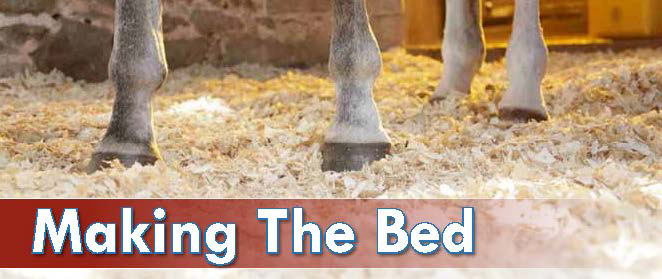|

There are several methods of mucking out or cleaning a stable, and deciding which one is best will likely depend upon time constraints and cost for the owner, the bedding used and also the horse’s behaviour when stabled.
The three main techniques are the full muck out, the deep litter system or the semi-deep litter system.
Full muck Out
With this method, all wet bedding and faeces are removed daily. The clean bedding is thrown up against the walls of the stable and the floor - now cleared – is left to dry (if the horse is turned out during the day). The bedding should be built up around the walls to create bankings to prevent horses becoming cast when lying down and help reduce draughts in the colder weather. If the horse is to remain in the stable during the day, the floor is sprayed with a disinfectant and the bedding raked back down again and any fresh bedding material (e.g. straw, wood shavings or a commercial bedding product) that is needed is put down. Some owners prefer to put down just a small amount of bedding (taken from that which was tossed up around the sides of the stable during the mucking out process), this being referred to as a ‘day bed’, which is replaced by the full bed and fresh bedding in the evening. The stable may also be ‘skipped out’ (droppings removed) several times during the day, if possible.
Deep litter bed
This system is tackled quite differently, with only the faeces removed and then a small amount of fresh bedding laid down to cover any wet areas. This is done daily, with a full clean out of the stable being done every few months (many do it twice yearly) at which point it is common to also clean and disinfect all walls and floors, leaving them to dry out fully before putting the bedding back in. It is generally used in cooler climates as, depending on the bedding used, it does generate heat.
Semi-deep litter
Faeces are removed daily (and a little fresh bedding added) with a full muck out carried out once a week to remove the urine soaked bedding and to lift the entire bed to allow the floor to be cleaned, dis infected, and to dry out. infected, and to dry out.
Bedding
The type of bedding used will impact on the time it takes to muck out a stable, and therefore can determine which system is more convenient for the owner. Some commercial beddings have a greater absorption ability than shavings, straw or sawdust and also can be beneficial environmentally. Faeces are relatively quick and easy to remove from a wood shavings bed for example, as they are easy to see and tend not to fall down into the bedding so much. Some commercial beddings moisture absorption qualities mean that it is easy to remove the wet areas as they ‘clump’. Straw bedding on the other hand can be more difficult to clean since it is less easy to spot the droppings and separate them from the straw, though some prefer a straw bed as it is generally considered more ‘luxurious’ and comfortable. In addition to this, whether the horse urinates and defecates in one particular part of the stable (rather than scattered over the entire area) also impacts on how easy mucking out will be and the time taken. Rubber matting is popular and can reduce the amount of bedding required. Cleaning of these should be as per the manufacturer’s recommendations.
Whilst deep litter is more economical time-wise on a daily basis (and cost-effective since little bedding is removed and therefore less fresh bedding required each day), there is no avoiding the fact that, when it comes to the full muck out every few months, removing all of the wet and dirty bedding is a considerable task and hard work! Many ensure the stable door is sufficiently wide enough to allow a small bobcat in to make the task less labour intensive. Many choose the semi-deep litter system – preferring to address the dirty bedding on a daily or weekly basis rather than letting the task build up.
If choosing to go with the deep-litter option, care should be taken to ensure dust and ammonia levels are kept under control (ammonia produced by faeces and urine irritates the respiratory tract, as does dust). This, and the risk of thrush developing in the hooves due to horses standing in wet bedding, are significant disadvantages with this method of maintaining stables. Ammonia-absorbing products are available, and also products that prevent the conversion of urea to ammonia, which may help alleviate respiratory problems in stabled horses. Cleaning the hooves out daily, and ensuring that fresh, dry bedding material is sprinkled over wet areas in deep-litter stables can reduce the risk of thrush developing.
Be sure to check out local council regulations when it comes to maintaining horse stables as many stipulate that bedding is to be cleaned daily. Keeping the horse healthy and comfortable is the priority, it is just a matter of finding the right bedding and method of cleaning to suit the horse and the owner’s time constraints and budge
|